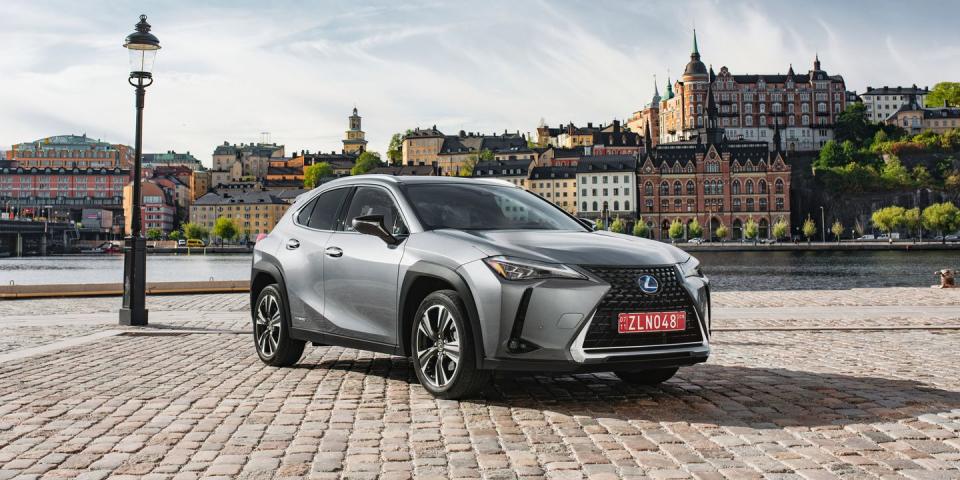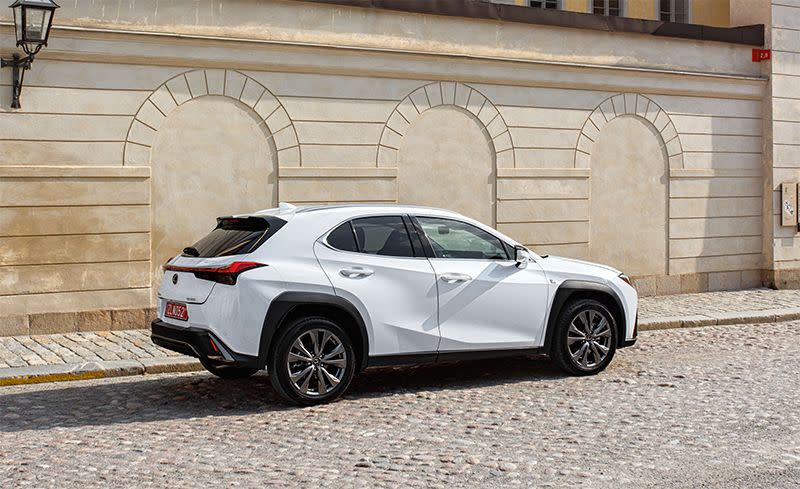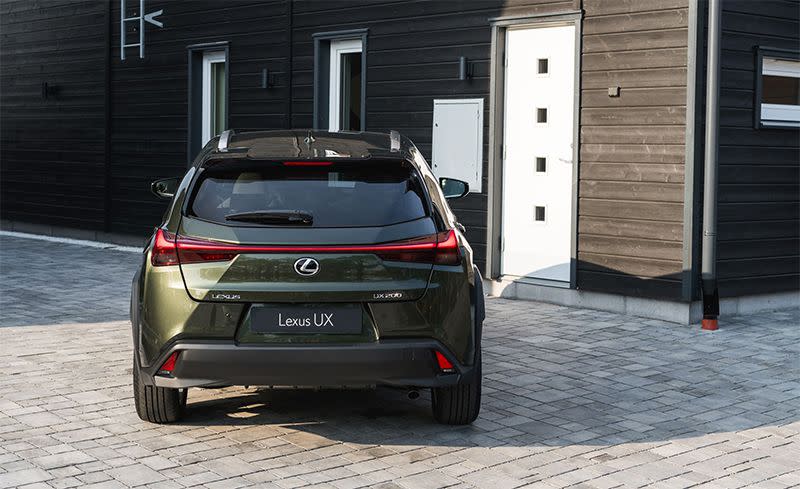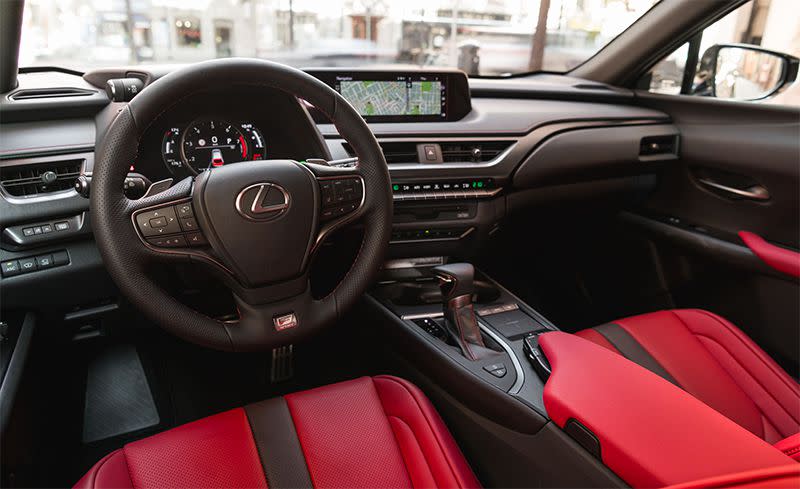The 2019 Lexus UX Is More Than a Dressed-Up Hatchback

The Cadillac Cimarron, a dressed-up Chevrolet Cavalier from the 1980s, has been the butt of jokes for decades. But today, no automaker is above slapping a luxury badge on a front-wheel-drive economy car and jacking up the price. Audi, BMW, and Mercedes-Benz all do it now with various entry-level models; even Aston Martin dabbled in the dark art with the Cygnet city car.
Lexus tried and failed once at this entry-luxury game. It turned out there wasn't much demand for the mildly luxed-up Prius that was the CT200h hybrid hatchback or-worse-the ungainly HS250h. But everybody wants crossovers nowadays, so that's what Lexus's new starter model is. For its latest dalliance with low-cost luxury, Lexus wisely hews closer to modern buyers’ preferences, proffering the new UX crossover. The UX is essentially a Toyota underneath, using the same underpinnings as the C-HR and the same base powertrain as the Corolla hatchback, but it incorporates the key tenets-plastic cladding, all-wheel-drive availability, and the L badge-that those Toyotas lack.
Smaller Than the Other Lexus Small SUV
The UX slots in below the NX in the Lexus lineup; it's about five inches shorter, five inches lower, and one inch narrower. That means it's about the same size as the Audi Q3, the BMW X1, and the Mercedes-Benz GLA, but because the larger NX competes with those cars, too, Lexus insists that price is the differentiator between the two siblings. The UX starts at $33,025. That undercuts the NX by more than $4000 while offering more standard features than the German competitors, which come sparsely equipped in their base forms. Numerous active-safety systems and Apple CarPlay are standard on the UX but cost thousands extra on the BMW X1, for instance.
Even though it's being pitched as a low-priced Lexus, the UX does a better job of imitating the luxury quotient of its big siblings than the German mini-utes do. A nice mix of materials inside includes expensive-feeling plastics, soft faux leather, and an interesting trim piece on the dash that’s meant to evoke a type of Japanese paper. Unfortunately, the frustrating infotainment touchpad carries over from other Lexus models. Curiously, the volume and tuning knobs have been relocated from the center stack to the center console where they're meant to fall to hand for a driver using the armrest. It seems logical, but the layout takes some getting used to, and we're not sure it's better than having those knobs on the dashboard.
Outsize Outside, Not Inside
The UX's small footprint is a limiting factor for cargo capacity, and packaging is not this vehicle's strong suit. The hatch opening is small with an uncomfortably tall lift-over height, and there's not much space to be had overall-just 17 cubic feet in the hybrid model and 22 in the standard version. Granted, most of the vehicles in this class don't shine in this respect, although the BMW X1 boasts 27 cubic feet of cargo space and the boxy Volvo XC40 has 32.
Lexus has gone far outside the box with the UX's styling and has applied a surfeit of flourishes for such a small package, perhaps to ensure that it won't be mistaken for a Toyota. It surely won't be, but it's also far from pretty. On the other hand, interesting color choices, including a green and an orange for the exterior and a two-tone blue-and-white interior option, help give the UX more youthful energy than other Lexus models can offer. We think the brighter colors show off the crossover's surface interest best.
Behind the Facade
If the UX is a commuter car under its wild skin, it's a good car to drive. We continue to be impressed with the dynamic qualities of Toyota models that ride on the brand's TNGA family of platforms, and the UX's chassis boasts progressive-feeling steering, nicely tuned damping, and a satisfying sense of quiet refinement. It is a shame that the best version we sampled, a UX200 with the F Sport package, won't be available in the United States with the adaptive dampers that were featured on the European example we drove. In the States, the F Sport package brings a retuned suspension along with a few visual upgrades and more supportive seats.
The powertrains are less convincing. The front-wheel-drive-only UX200's 169-hp 2.0-liter inline-four sounds coarse at higher revs, and while the continuously variable automatic transmission (CVT) it pairs with works well enough, this combo has nothing on the German mini-crossovers' strong turbocharged fours. The UX250h's hybrid drivetrain offers a total of 175 horses and modest all-wheel-drive capability, courtesy of a small electric motor lashed to the rear axle (which only works at speeds up to 45 mph). It's quieter than the base engine but still doesn't feel as if it belongs in a luxury car.
At least both of these economy-car-like powertrains provide economy-car-like fuel economy, ranging from 33 to 38 mpg combined, according to the EPA. Lexus claims that the latter number makes the UX250h hybrid the most efficient vehicle without a plug that's categorized as a crossover or SUV-although that's splitting some fine hairs.
Our more cynical side wants to deride Lexus for pandering to badge snobs with a vehicle that amounts to little more than a dressed-up econobox. But all the cool kids are doing it these days, and the UX is mostly convincing in its impersonation of a premium product thanks to its plush interior, agreeable demeanor, and-yes-even its polarizing looks.
('You Might Also Like',)

 Yahoo Autos
Yahoo Autos 


